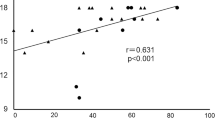Summary.
In the present study, we evaluated the effect of pergolide, a mixed D1/D2 agonist, on cognitive function in mild Parkinson’s disease (PD). After a two-week wash-out phase, twenty patients with a Hoehn and Yahr score ≤2.5 entered a 16-week, cross-over study in which the order of administration of pergolide or 1-dopa was randomly assigned. Cognitive assessment was performed after the wash-out phase and repeated after eight weeks (before patients were switched to the other drug) and at the end of the study. There were no significant differences in test scores among the three experimental modalities (off-treatment vs. l-dopa, off-treatment vs. pergolide, pergolide vs. l-dopa).
In another cohort of comparably mild PD patients we had previously demonstrated that pramipexole, a mixed D2/D3 agonist, slightly but significantly worsened verbal fluency in comparison to l-dopa; moreover, pramipexole impaired short term verbal memory and attentional-executive functions in comparison to both l-dopa and the off-treatment condition. Taken together, these findings suggest that dopamine agonists may influence cognition in PD according to their pharmacological characteristics. Unlike the D2/D3 agonist pramipexole, pergolide and l-dopa, both of which stimulate D1- and D2-receptor subtypes, do not appear to impair cognitive function.
Similar content being viewed by others
Author information
Authors and Affiliations
Rights and permissions
About this article
Cite this article
Brusa, L., Tiraboschi, P., Koch, G. et al. Pergolide effect on cognitive functions in early-mild Parkinson’s disease. J Neural Transm 112, 231–237 (2005). https://doi.org/10.1007/s00702-004-0193-0
Received:
Accepted:
Published:
Issue Date:
DOI: https://doi.org/10.1007/s00702-004-0193-0




